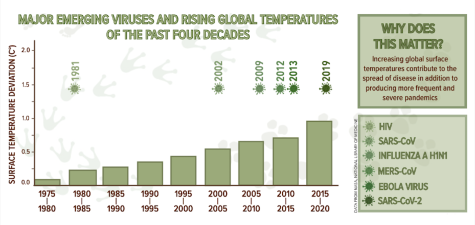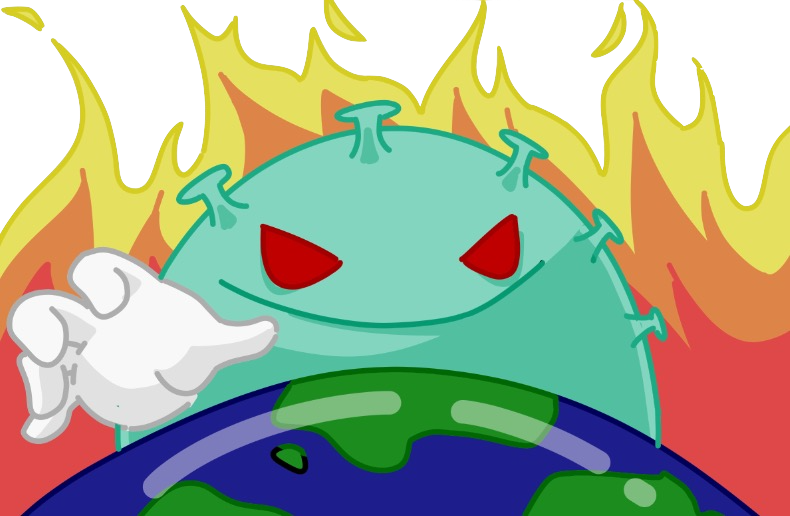Global Reset: How climate change infects our world
Global warming triggers spread of viral diseases
An illustration of a virus approaching the Earth. Global warming has led to increased disease spread, with warmer temperatures, greater animal migration and the uncovering of viruses from the permafrost.
We’re now living three years after the COVID-19 pandemic, an event that took the lives of 6.6 million and permanently changed our meaning of “normal.” COVID-19 isn’t the first nor the last of deadly viral outbreaks, with the 1968 Influenza A pandemic and the 1981 HIV epidemic producing similar effects. Cases of new emerging viruses are more common now, with a 22-28% chance of the next pandemic of the same severity as COVID-19 taking place within a decade. But what is causing this, and how can we stop it? Despite the perhaps unexpected connection, part of the evidence points to climate change.
The main source of climate change-caused spread of disease is increased cross-species interactions spurred by animal migrations due to the destruction of ecosystems. Through burning, melting, shrinking and more, global warming wears away at animal habitats. The effects are increasing exponentially at unprecedented rates as seen in Greenland, where a currently melting ice sheet will result in a 10.6 inch increase in sea levels, twice the amount initially predicted. Just a foot increase in sea levels swallows up to 100 feet of coastline, displacing thousands of animals. Worse, rising levels threaten one in six endangered species, according to a study by the Center for Biological Diversity.
“Since the real issue is climate change, anything to reduce the change in temperature, which creates these issues for these [animals], is probably a good step to actually treat the specific symptoms of the situation,” Research Club officer Arnav Swaroop (11) said. “To try, you could leave some amount of land like forest land untouched and constrict human urbanization.”
From rising sea levels to wildfires, habitat destruction not only wipes out species but also leaves animals with no place left to go — except towards the poles. Around 50% of all wildlife are migrating in search of cooler climates and new habitats, with some species traveling over 40 miles a decade.
As animals trek across the globe, they come into contact with other species that they wouldn’t have run into under normal circumstances. These cross-animal interactions permit new viruses, called zoonotic diseases, to jump from host to host. Often, these viruses have not been previously encountered by the animal, fostering unprecedented rates of disease transmission. Notably, 75% of recent viral diseases, including COVID-19, originated from animals, and these incidents increase both the frequency and the severity of pandemics, due to expedited transmission.
In addition to animals spreading viruses, permafrost, ground frozen for two years or longer, is melting at rapid rates, releasing new infectious diseases. Although permafrost primarily occupies Arctic regions, these viruses can escape into water supplies as well as piggyback on animals as they migrate. Currently, permafrost temperatures are rising at around 0.6 degrees Fahrenheit each decade. Just a three degree increase in global temperatures can melt up to 85% of permafrost layers.
“These layers of permanently frozen soil thawing have viruses in there [that] the earth hasn’t seen in potentially millions of years,” upper school biology teacher Dr. Matthew Harley said. “Certainly humans haven’t seen them and had any immune system response to them.”
With increased disease transmission comes higher mutation rates, so although global warming doesn’t cause viruses to mutate on the biological level, warmer weather directly links to spread of disease, according to Dr. Harley.
“One of the aspects [of] warmer weather is that people are more likely to be outside and interacting with each other,” Dr. Harley said. “Viruses spread better, obviously, through human contact, [but] when it’s cold, when people are more isolated by themselves or with families, we do often see a lower spread of viruses.”
Although action against climate change is a widespread movement, debates over whether authorities and the general public are doing enough continue. Even though countries have pledged to lower carbon dioxide levels to combat climate change, few have followed through with their promises. Similar to Arnav, Public Health Club officer Young Min (10) appreciates the implemented policies but believes that the issue is only solvable if the public and authorities are more involved in the movement.
“I think [climate change] is solvable if we take it seriously,” Young said. “The government has to be willing to change in order for climate change, [and], as a global population, we [need to] take the initiative to collectively lower our [carbon dioxide] emissions and actually care for our planet.”
Especially in the COVID-19 pandemic, with 42% of adults displaying distrust in vaccines, belief in science has waned. So, in combating climate change, Dr. Harley emphasizes the importance of education in a time when global warming’s effects are increasing unpredictably.
“A lot of people have lost their faith in science and don’t understand how science is done, how much we know from the scientific studies and how believable they really are,” Dr. Harley said. “So educate yourself, help educate others both more generally about science but then about potentially these individual viruses and their diseases. [Most importantly], heed the cautions that scientists and doctors are trying to spread.”


Shareen Chahal (12) is a co-managing editor for the Winged Post, and this is her third year on staff. This year, Shareen hopes to extend her coverage to...

Kinnera Mulam (12) is the co-editor-in-chief of the Winged Post, and this is her fourth year on staff. This year, Kinnera hopes to get to know all the...

Jessica Wang (12) is a Managing editor for the Winged Post, and this is her fourth year on staff. This year, she wishes to cover a greater breadth of content...


















![“[Building nerf blasters] became this outlet of creativity for me that hasn't been matched by anything else. The process [of] making a build complete to your desire is such a painstakingly difficult process, but I've had to learn from [the skills needed from] soldering to proper painting. There's so many different options for everything, if you think about it, it exists. The best part is [that] if it doesn't exist, you can build it yourself," Ishaan Parate said.](https://harkeraquila.com/wp-content/uploads/2022/08/DSC_8149-900x604.jpg)




![“When I came into high school, I was ready to be a follower. But DECA was a game changer for me. It helped me overcome my fear of public speaking, and it's played such a major role in who I've become today. To be able to successfully lead a chapter of 150 students, an officer team and be one of the upperclassmen I once really admired is something I'm [really] proud of,” Anvitha Tummala ('21) said.](https://harkeraquila.com/wp-content/uploads/2021/07/Screen-Shot-2021-07-25-at-9.50.05-AM-900x594.png)







![“I think getting up in the morning and having a sense of purpose [is exciting]. I think without a certain amount of drive, life is kind of obsolete and mundane, and I think having that every single day is what makes each day unique and kind of makes life exciting,” Neymika Jain (12) said.](https://harkeraquila.com/wp-content/uploads/2017/06/Screen-Shot-2017-06-03-at-4.54.16-PM.png)








![“My slogan is ‘slow feet, don’t eat, and I’m hungry.’ You need to run fast to get where you are–you aren't going to get those championships if you aren't fast,” Angel Cervantes (12) said. “I want to do well in school on my tests and in track and win championships for my team. I live by that, [and] I can do that anywhere: in the classroom or on the field.”](https://harkeraquila.com/wp-content/uploads/2018/06/DSC5146-900x601.jpg)
![“[Volleyball has] taught me how to fall correctly, and another thing it taught is that you don’t have to be the best at something to be good at it. If you just hit the ball in a smart way, then it still scores points and you’re good at it. You could be a background player and still make a much bigger impact on the team than you would think,” Anya Gert (’20) said.](https://harkeraquila.com/wp-content/uploads/2020/06/AnnaGert_JinTuan_HoHPhotoEdited-600x900.jpeg)

![“I'm not nearly there yet, but [my confidence has] definitely been getting better since I was pretty shy and timid coming into Harker my freshman year. I know that there's a lot of people that are really confident in what they do, and I really admire them. Everyone's so driven and that has really pushed me to kind of try to find my own place in high school and be more confident,” Alyssa Huang (’20) said.](https://harkeraquila.com/wp-content/uploads/2020/06/AlyssaHuang_EmilyChen_HoHPhoto-900x749.jpeg)





Evan Michaeli • Dec 11, 2022 at 12:27 pm
Hi all,
This is Evan Michaeli, senior writer of The Gator, the school newspaper for Brimmer and May in Chestnut Hill, Massachusetts. As a climate activist myself, I look for different ways to express the damage climate change will have on humanity. Disease control is often overlooked, and I appreciate this article brought attention to the issue. I also enjoyed the graphics. Excellent job!